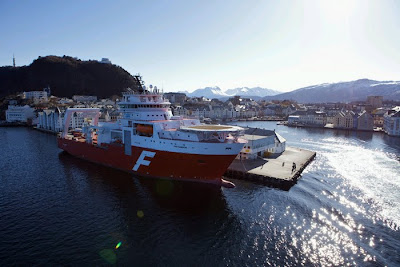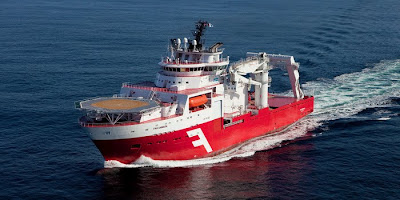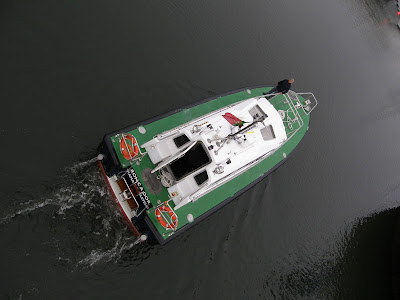Pict 1.
The Pilot Boat
Sunday, October 28, 2012
Luanda Memories
Pict 1.
Saturday, December 11, 2010
More on safety drills...
Monday, November 22, 2010
Drydocking
Monday, November 08, 2010
Pilot boarding
Saturday, October 30, 2010
Old or classic?
Some old ships still have the beautiful brass shining all over the bridge. If well kept they become classic ships instead of old rust buckets.
Tuesday, October 19, 2010
Gil Eannes
Sunday, October 10, 2010
Stella Polaris
I boarded the vessel and recognized the captain from previous voyages. I presented him the pilotage passage plan and he explained me the vessel’s characteristics. We didn’t loose too much time with this as I already know the vessel and the captain already knows the port, so I just draw his attention to the prevailing port conditions, like the expected traffic, wind and tidal current, under keel clearance, and how I was planning to take the vessel alongside.
By the time we were at about 2 cables from the breakwaters the visibility improved a lot and as the captain is familiar with the passage I just told him to steer in the middle of the channel.
On the last pair of buoys I took the con and started positioning the vessel in order to go starboard side alongside. I ordered slow astern to take some speed off and used the bow thruster half speed to starboard to approach the bow and pass a spring line ashore. The combined effect of the side thrust of the propeller (acting like right handed) and the tidal current on the starboard quarter started swinging the vessel across the river making an angle to the berth that would make it impossible to bring the stern alongside.
I immediately decided to go for an alternative manoeuvre that I use when the current is astern (which I had underestimated because it was a neap tide). I ordered hard to port the wheel, bow thruster full to port, and gave a kick ahead in order to swing the vessel rapidly to port, to put the tidal current on the port quarter. Once I had the current on the port quarter I started coming astern to the berth, steering with the bow thruster. With the vessel making the proper angle with the river the tidal current acts like a “silent tug”, helping to berth the vessel. Also, when the vessel is going astern the pivot point also moves astern enhancing the effect of the bow thruster. In this way I just had to approach the stern of the vessel to pass a sternline and then, using the bow thruster, paralleled the berth.
I enjoy this kind of manoeuvre (as long as the bow thruster has enough power to compensate the side thrust effect of the propeller) because you take full use of the bow thruster and always have the possibility to correct the positioning of the aft section by giving a kick ahead with the rudder full to either side. Nevertheless most captains feel uncomfortable with this “going astern” to the berth, whether because not used to it or not trained to do it. In this particular case, we had already done it so it was not a surprise to the captain, which knows we can’t swing and go portside alongside on this berth.
Naturally I could have used the tug boat that was standing by (compulsory for tankers), but that wouldn’t be half the fun…
After the vessel was safely moored with 3 headlines and 2 springlines forward and 3 sternlines and 2 springlines aft I disembarked to the pilot boat and went back to the pilot station to finish the paperwork and prepare the next manoeuvre.
Monday, May 24, 2010
FAR SAMSON
FAR SAMSON-Ship of the year 2009
Awarded by: Ships
Please se bellow the main features of this state of the art offshore vessel, I apologise by the long list but just reading it we have a full picture of how mighty the vessel is.
Built / Yard
2009/ STX Offshore
Main Class +1A1, SF, E0, DK(+), Supply Vessel
Basic, Tug, COMF-V(3)C(3), Clean Design, DYNPOS-AUTRO
NAUT OSV(A), TMON, CRANE, DEICE, BIS, HELDK-SH
Loa / B.mld 121,5m / 26m
Draft (max) 8,5m + 0,97m Nozzle
Deadweight/GRT 6103mt (d=8,5m)/GRT 14740mt
Cargo Deck Area 1450m2
Deck Load 2300mt
Deck Strength 15mt/m2
Deck Crane 1 x SWL 250mt@14m
Main deck crane Active Heave Compensated max. work radius 36 m
1 x SWL 20mt@20m ROV support crane Active Heave Compensated
A-Frame 1 x SWL 315mt@seastate 4 active Heave Compensated
Moonpool1 of 7m x 7m
ROV Hangar 1
Helideck Yes
Fuel Oil 3400m3
Pot Water 1200m3
Drill Water/WB 5700m3
Main Engines
Hybrid propulsion system, Diesel mech. 4 x 6000 KW (4 x 8160 BHP) & Diesel electrical 4 x 2755 kW.
Total propulsion effect: 35900BHP on main propellers
Cathalytic Converters Yes
Bow/Stern Thrusters 1 x 2450BHP / 2 x 1632BHP
Azimuth Thruster 2 x 1800 KW forward,
1 x 1800 KW aft. Total 7344BHP
Bollard Pull 423mt
Speed (service/max) 13 knots/19 knots
Consumption 35mt/24 hrs - 105mt/24 hrs
Work Tow Drum 1 x 600mt - 2500m of 103 mm wire
Rope/reel storage1 x 3000m/103 mm wire or 2 x 1500m/103mm
Tow Pins 2 Max work Load = 400 metric ton
Shark Jaw 1 Max work Load = 800 metric ton
Stern Roller 6m x 4500m dia - MWL 1000mt
Accommodation 100 Persons

Pict.1

Pict.2

Pict.3

Pict.4

Pict.5

Pict.6

Pict.7

Pict.8

Pict.9
All the best, be safe and take care out there.
José Saraiva.
Sunday, May 16, 2010
New Pilot Boat "Roncador"
The new pilot boat "Roncador" (Port of Viana do Castelo) arrived the 14th at 0900 after a technical call at Leixões where her sister "Gilreu" was delivered. Built by the Portuguese shipyard ENP (Estaleiros Navais de Peniche) she will now be submitted to local inspections and register and is scheduled to start operating within the next few days.
More photos and boat details will be posted soon.
Friday, April 02, 2010
Abel Matutes, this afternoon
 |
| Abel Matutes being pulled from drydock (with propellers still not running) by tugboat Monte do Leça. |
 |
| Vessel swinging towards South. |
 |
| Vessel headed to port entrance, pilot boat Quebramar waiting for the Pilot. |
 |
| Passing by Atlântida. |
 |
| Close up view on the port bow. The colleague had the time to come to the port wing and wave at me... |
 |
| Pilot boat approaching to pick the Pilot, vessel increasing speed, destination Vigo. |
Abel Matutes, the largest vessel ever to be handled at Viana do Castelo:
LOA: 190,5m
GT: 31 259t
Tuesday, March 30, 2010
Aurora
 |
| Pilot and Captain on the bridge wing discussing the intended maneuvering. |
 |
| Tugboat Monte S. Brás pulling on the center fairlead, tugboat Monte Xisto standing by. |
 |
| Vessel clearing the dock, bow controlled with shore lines. |
 | |||
| Vessel out, ready to shift to fitting out basin. |
Molten Sulphur Tanker
LOA 170m
GT 16 454t
Built 2000 (Viana do Castelo hull 206)
Flag Marshall Islands





























